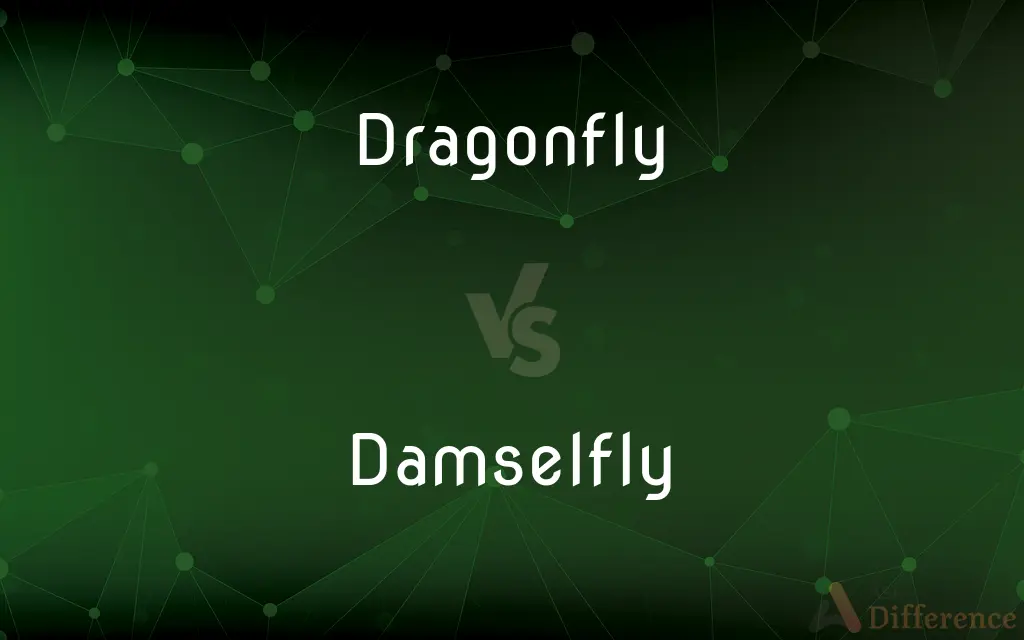Dragonfly vs. Damselfly — What's the Difference?
By Tayyaba Rehman — Updated on September 20, 2023
Both are insects of the order Odonata, but dragonflies are robust with wings spread out at rest, while damselflies are slender with wings folded over their backs when resting.

Difference Between Dragonfly and Damselfly
Table of Contents
ADVERTISEMENT
Key Differences
Dragonflies and damselflies are both members of the Odonata order, with dragonflies belonging to the suborder Anisoptera and damselflies to the Zygoptera. This classification means they share many similarities, yet they are distinct creatures.
One of the most distinguishing features between a dragonfly and a damselfly is their body structure. Dragonflies tend to have robust, broader bodies, while damselflies have slender, more delicate bodies.
In terms of wing positioning, a dragonfly rests with its wings open and perpendicular to its body. In contrast, a damselfly will usually keep its wings closed and parallel to its body when at rest.
The eyes of a dragonfly are larger, often touching each other, giving them an almost seamless appearance. On the other hand, damselflies have eyes that are more separated and set on each side of their heads.
When observing them in their habitats, dragonflies are generally stronger fliers, often seen darting quickly over water or fields. Damselflies, though also agile, have a more fluttery, lighter flight.
ADVERTISEMENT
Comparison Chart
Body Structure
Robust and broad body.
Slender and delicate body.
Wing Position at Rest
Wings spread out, perpendicular to body.
Wings folded over the back, parallel to body.
Eyes
Large and often touching each other.
Smaller and more separated.
Flight
Stronger and darts quickly.
Lighter, more fluttery flight.
Suborder
Anisoptera.
Zygoptera.
Compare with Definitions
Dragonfly
Insect Predator: A fast-flying insect known for its predatory skills.
The dragonfly zipped over the pond, catching mosquitoes.
Damselfly
Separated Eyes: Has eyes that are set apart on its head.
The damselfly's separated eyes gave it a unique look.
Dragonfly
Perpendicular Wings: Rests with wings spread out, away from the body.
The dragonfly sunned itself, wings fully spread on the rock.
Damselfly
Delicate Insect: A slender-bodied flying insect, often seen near water.
The damselfly fluttered gracefully over the stream.
Dragonfly
Anisoptera Member: Belongs to the Anisoptera suborder of Odonata.
The Anisoptera dragonflies are easily distinguishable from their damselfly cousins.
Damselfly
Parallel Wings: Rests with wings folded neatly over its back.
The resting damselfly looked like a delicate twig with its wings aligned.
Dragonfly
Large Eyes: Possesses large compound eyes that often touch each other.
The dragonfly's eyes gave it almost 360-degree vision.
Damselfly
Zygoptera Member: Belongs to the Zygoptera suborder of Odonata.
Zygoptera damselflies are different from the more robust dragonflies.
Dragonfly
Broad-Bodied: An insect characterized by a robust and wide body.
The bright blue dragonfly was easily noticeable because of its size.
Damselfly
Light Flight: Exhibits a fluttery and light mode of flight.
The damselfly seemed to dance in the air with its soft flight.
Dragonfly
A dragonfly is an insect belonging to the order Odonata, infraorder Anisoptera (from Greek ἄνισος anisos, "unequal" and πτερόν pteron, "wing", because the hindwing is broader than the forewing). Adult dragonflies are characterized by large, multifaceted eyes, two pairs of strong, transparent wings, sometimes with coloured patches, and an elongated body.
Damselfly
Damselflies are insects of the suborder Zygoptera in the order Odonata. They are similar to dragonflies, which constitute the other odonatan suborder, Anisoptera, but are smaller and have slimmer bodies.
Dragonfly
Any of numerous predatory insects of the order Odonata, having large eyes, a long slender body, and two pairs of transparent veined wings, especially those of the order Anisoptera, which hold the wings outstretched when at rest, as distinguished from the damselflies. Also called regionally darner, darning needle, devil's darning needle, mosquito fly, mosquito hawk, needle, skeeter hawk, snake doctor, snake feeder, spindle.
Damselfly
Any of numerous often brightly colored, predatory odonate insects of the suborder Zygoptera that have a long slender body with transparent veined wings and that, unlike dragonflies, hold the wings together over the abdomen when at rest. Also called demoiselle.
Dragonfly
An insect of the suborder Epiprocta or, more strictly, the infraorder Anisoptera, having four long transparent wings held perpendicular to a long body when perched.
Damselfly
Any of various insects of the suborder Zygoptera that have long slender bodies, and are similar to dragonflies but having wings folded when at rest.
Dragonfly
Slender-bodied non-stinging insect having iridescent wings that are outspread at rest; adults and nymphs feed on mosquitoes etc.
Damselfly
A slender nonstinging insect similar to but smaller than the dragonfly but having wings folded when at rest.
Damselfly
Slender non-stinging insect similar to but smaller than the dragonfly but having wings folded when at rest
Common Curiosities
Are dragonflies and damselflies related?
Yes, both belong to the order Odonata but are different suborders.
Can damselflies and dragonflies harm humans?
No, they are harmless to humans and do not sting or bite.
How do dragonflies and damselflies reproduce?
Both lay eggs in water, and their larvae develop in aquatic environments.
Which is bigger, a dragonfly or a damselfly?
Dragonflies are generally larger and more robust than damselflies.
Do both dragonflies and damselflies live near water?
Yes, both are typically found near water bodies as their larvae are aquatic.
Do dragonflies and damselflies migrate?
Some species, especially certain dragonflies, are known to migrate over long distances.
What do dragonflies and damselflies eat?
Both are predators, primarily feeding on smaller insects.
Are dragonflies more aggressive than damselflies?
Dragonflies are strong predators and can be more aggressive in their hunting habits than damselflies.
Do both dragonflies and damselflies undergo metamorphosis?
Yes, both undergo a process of metamorphosis from larval to adult stages.
Why are dragonflies' eyes so large?
Large eyes give dragonflies a broader range of vision, aiding in hunting and navigation.
Are damselflies as colorful as dragonflies?
Both dragonflies and damselflies can exhibit vibrant colors, though it varies by species.
Do both dragonflies and damselflies have the same lifespan?
Lifespan varies by species, but typically, in their adult form, they live for several weeks to a few months.
Are dragonflies and damselflies beneficial for the ecosystem?
Absolutely, they help control mosquito populations and serve as food for other animals.
Can dragonflies and damselflies fly in rain?
While they can fly in light rain, heavy rain can impede their flight.
Are dragonflies faster than damselflies?
Yes, dragonflies are generally faster and stronger fliers compared to damselflies.
Share Your Discovery

Previous Comparison
Said vs. Says
Next Comparison
Rock vs. DiamondAuthor Spotlight
Written by
Tayyaba RehmanTayyaba Rehman is a distinguished writer, currently serving as a primary contributor to askdifference.com. As a researcher in semantics and etymology, Tayyaba's passion for the complexity of languages and their distinctions has found a perfect home on the platform. Tayyaba delves into the intricacies of language, distinguishing between commonly confused words and phrases, thereby providing clarity for readers worldwide.














































